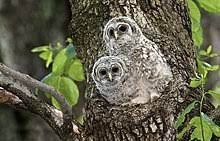Barred owls like wet, mixed-tree woods to inhabit year-round. Possibly because old woodlands offer a greater diversity of prey and are more likely to have big cavities appropriate for nesting, they prefer to be found in huge, unfragmented blocks of mature forest. In addition to hemlock, maple, oak, hickory, beech, aspen, white spruce, quaking aspen, balsam poplar, Douglas-fir, lodgepole pine, and western larch, their preferred habitats also include wetlands, streamside areas, and uplands.

The ideal nesting location for a barred owl is 20-40 feet above the ground, in a tree with a naturally occurring hollow. Both natural stick platforms and artificial nest boxes constructed by humans are used. As we’ll see in this piece, these owls have some fascinating nesting behaviors. Their nesting behavior is opportunistic but cautious, like that of many other owls.
A barred owl may spend up to a year monitoring a potential nesting location before deciding to make it it’s a permanent home. As they only raise one brood each year, it is crucial that their nesting spot be secure and conducive to raising healthy young. They check that a previously used nesting place is abandoned and keep an eye out for animals that might eat their eggs.
Food

Squirrels, chipmunks, mice, voles, rabbits, birds (up to the size of grouse), amphibians, reptiles, and invertebrates are all on the menu for these nocturnal predators. They wait for their prey from a high vantage point, then use their keen senses of sight and hearing to track it down. They can swoop down from above to grab fish, or they can wade into the water and hunt for crayfish and other aquatic creatures. Even though they typically hunt after dark, they have been observed feeding throughout the day. The nest, the fork of a branch, or the top of a snag are all possible locations for a Barred Owl to temporarily store its prey. They chew their food thoroughly before swallowing it whole or in parts, depending on the size of the animal; they start with the head and move on to the rest of the body with larger prey.
Nesting

The typical nesting location for a barred owl is in a huge tree, 20-40 feet above the ground. Animals like hawks, crows, ravens, and squirrels (among others) may use stick platforms constructed by humans as nests. Sometimes it takes a year or more for a Barred Owl to finally settle on a nesting site after visiting several potential locations. We don’t know if it’s the female or man that makes the decision.
Nest Description
When relocating into an existing tree hole or using an abandoned platform nest, Barred Owls rarely make any structural changes. The top of an old squirrel nest may be flattened or removed, and lichen, new green conifer sprigs, or feathers may be added to a stick platform nest. The width and depth of the cavities are respectively 10-13 and 14-21 inches (sometimes much deeper, with one cavity recorded as nearly 8 feet deep).
Where can one find barred owlets’ nesting grounds?

The preferred nesting location for barred owls is usually in a tree at a great height. Typically, they’ll locate a huge hole in a tree some 20–40 feet in the air. However, they have also been observed utilizing the nests of other bird species. Hawks, crows, and ravens will gladly make use of a stick platform nest. However, Barred Owls rarely construct their own nest. They would rather enter a tree through a hole or cavity.
Also, know Do owls come out during the day?
When it comes to nesting, what trees do barred owls prefer?
For their nests, barred owls prefer conifers like cedar, fir, spruce, and pine. These owls prefer to live in mature trees and woodlands. The reason for this is that older trees typically have more natural holes in them, making them ideal nesting locations for these birds. They feel safer in a tree with thick branches and leaves.
When do barred owls typically start nesting?

A barred owl’s courtship season begins in February, yet the birds flirt all year round. It can breed from March to August. When that time comes, the owls will start looking for a home for their young.
How long do barred owls typically roost in their nests?
The parents of a young barred owl will stay with the nest until the young are old enough to fly away and establish their own territories. Barred owls are unusual among owls in that they provide parental care for their offspring for roughly four months. After this, the young bird is fully grown, has all of its adult feathers, and is prepared to leave its nest and begin a new life. The parents will abandon the nest, though they may come back the next year.
How do barred owls often construct their nests?
Much like other owl species, barred owls rarely if ever construct nests. Instead, they’ll use a tree’s natural cavity as a nesting site. The only thing that could be on the floor of the nest would be owl feces.





